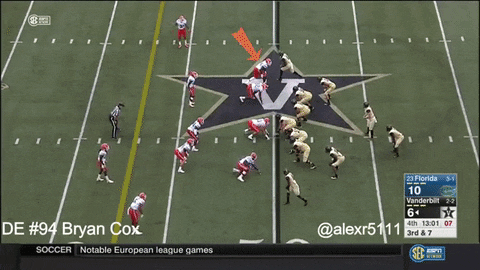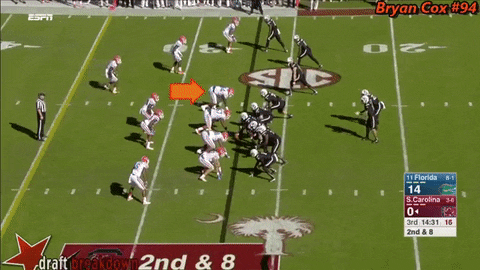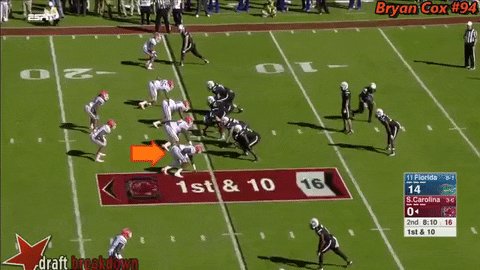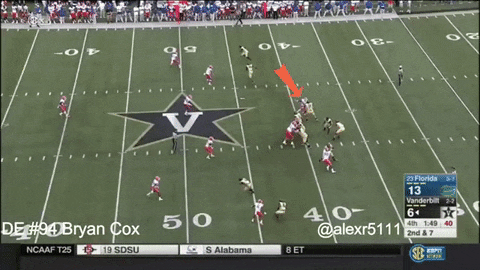ALL TWENTY-TUESDAY: FLORIDA DE, BRYAN COX JR.
What do you carry in your last name?
For me, carrying the name “Sikkema” means to carry a sense of hardworking pride. My great grandfather forged his way to America from the Netherlands. My grandfather worked countless hours on a milk truck in Patterson, New Jersey rain or shine for decades, and also served in the Korean War. My father, who was raised in such conditions with five siblings, moved from New Jersey to Florida in his early twenties with no connections or ties to the state. He started off living in someone’s garage, working for a landscape company sun-up to sun-down doing hard labor for any source of income. Now, he owns that landscaping company and has turned it into one of the most successful companies in its field in the entire southwest coast.
That’s what I carry when I write down the name “Sikkema”; that’s some of the history I call my own.
The same is true for Florida defensive end Bryan Cox, Jr., who carries around a legacy just by introducing himself. The name “Bryan Cox” is already known around the NFL. Cox, Jr.’s father, Bryan Cox, Sr., played for the Miami Dolphins in the early 1990s where he went to three Pro Bowls. In his father’s 12-year NFL career, Cox amass 938 tackles, 51.5 sacks and four interceptions. He also won a Super Bowl in 2002 with the New England Patriots.
Since his playing days, Cox. has kept the family name relevant. He has been a defensive line coach for the Jets, Browns, Dolphins and even the Buccaneers under Greg Schiano. This week he’s preparing his current team for the Super Bowl as the defensive line coach of the Atlanta Falcons.
Cox has kept his family name known around the NFL up until now where it’s time for his son to take up the torch. So what is it that Cox, Jr. can now build off the foundation of his family name? Let’s identify where his own legacy will start.

I think we as a football community have a bad habit of labeling defensive ends run stoppers when they can’t bend the edge well as a pass rusher. Just because a defensive end isn’t a good pass rusher doesn’t automatically make him a power guy or a guy who is good at stopping the run.
I say that because Bryan Cox, Jr. is that powerful run defender type, and the skill deserves to be recognized instead of making it feel like it’s something we settle for.
If you believe that disruption is production, which I do (shoutout to Josh Norris), then the play above is for you. Cox, Jr.’s game tape has a good amount of power rushes in it with success relative to the play above. His bullish style of rushing doesn’t yield too many sacks, but it does collapse a pocket relatively quickly. Cox’s best trait is using good technique and above average strength to get into players, knock them off balance or disengage their arms with a good swim or rip move.
This also comes in handy when defending the run, as the 6-foot-3, 269-pound Cox has the patience to engage blockers, wait for a play to develop, then rip off his lineman and make a tackle at the line of scrimmage. That’s how you turn power into run stopping, but you also need the right technique and patience, two areas of Cox’s game we’ll expound upon below.

Though he is much more of a power rusher than a edge bender, there are times when Cox can put together good snap anticipation, a great rip or swim move and flip his hips fast enough to get to a quarterback in a shotgun drop.
The sack above is the result of good technique, courtesy of Cox’s active hands. As he approached his blocker, Cox whipped his hands in front of and above the lineman’s extended arms. This allowed for him to put the lineman’s arms down and away from his chest as to give him a free run around offensive lineman.
This is what scouts are talking about when they reference good hand technique with defensive lineman. When lineman are just throwing their hands around without a purpose, the good offensive lineman can detect this and still engage through the chaos. But when pass rushers are smart with their active hands – even ones that aren’t the most athletic or explosive, like Cox – sometimes they can still get the better of a good blocker.

Cox is not only a powerful defensive end, but he’s also an intelligent one.
The play above is of him containing the edge on a run-pass option. There are plenty of defensive ends who would see the designed free lane to the quarterback, get wide-eyed and take off into the backfield as to try to stop the play at the exchange between the quarterback and running back. If a defensive end were to do that, or even just take a few steps in that direction, the quarterback would keep the ball and run around the edge for a big gain. In the clip above, Cox instead had the awareness to stay put and force a run inside knowing there was help there. That’s a smart football play.

Even with a strong punch, good technique and good patience, there’s a reason why we’re not talking about Cox as a first-round prospect. In fact, he’s a middle-to-late-round prospect.
The first reason, to me, is his inconsistent jump on snaps. Cox has gotten better at this throughout his career, and I even saw him do it more at the East-West Shrine practices, but overall there are too many instances like the one above where Cox is the last one out of his stance.
For a player who is already behind the eight ball when it comes to getting bend around edges, being slow out of his stance renders Cox as neutralized before he even has a chance to get into his offensive lineman. This is an area of his game he must improve (if he can, such a trait is not always a guarantee).

The reason there is such a need for better snap anticipation and a quick reaction time is because of the clip above; Cox simply isn’t a natural edge bender. But neither in Tampa Bay defensive end William Gholston.
Cox is not a guy who can flex his ankles to make his body go forward at low angles to dip around offensive lineman. Cox has to work hard to give himself an extra step or two of separation just to make sure he can flip his hips completely to turn the corner at an angle that would still allow him to get to a quarterback in a five or seven-step drop.
Instead, the result is too often the one we see above, where Cox is flying by the pocket at an angle that is non-disruptive where a quarterback can easily take a step forward and avoid his pressure. This lack of natural bend and only 10 career sacks, including just half a sack last year as a senior, is why he’s projected to be a Day 3 pick.
There is one trait of Cox game that I saved for last, and that is: relentlessness.
Above all, Cox is a worker – and I mean that in every sense of the word. His father was the same way. You don’t have a 12-year career in the NFL without being relentless in what you pursue, both in outside achievements, and in upholding the standard you have for yourself as a player.
Cox has learned how to play defense end, stand up linebacker and defensive tackle, just to make sure he gets on the field. Between the whistles, he’s a constant worker who doesn’t stop running until the play is stopped. Throughout his career, he’s improved on certain parts of his game little by little. He retains coaching well, and I believe that can be credited toward his restless competitive nature.
Relentless is the word that comes to mind when I think of the last name “Cox” in the game of football. That’s what Bryan Cox, Jr. carries with his name.
Trevor Sikkema is the Tampa Bay Buccaneers beat reporter and NFL Draft analyst for PewterReport.com. Sikkema, an alumnus of the University of Florida, has covered both college and professional football for much of his career. As a native of the Sunshine State, when he's not buried in social media, Sikkema can be found out and active, attempting to be the best athlete he never was. Sikkema can be reached at: [email protected]



